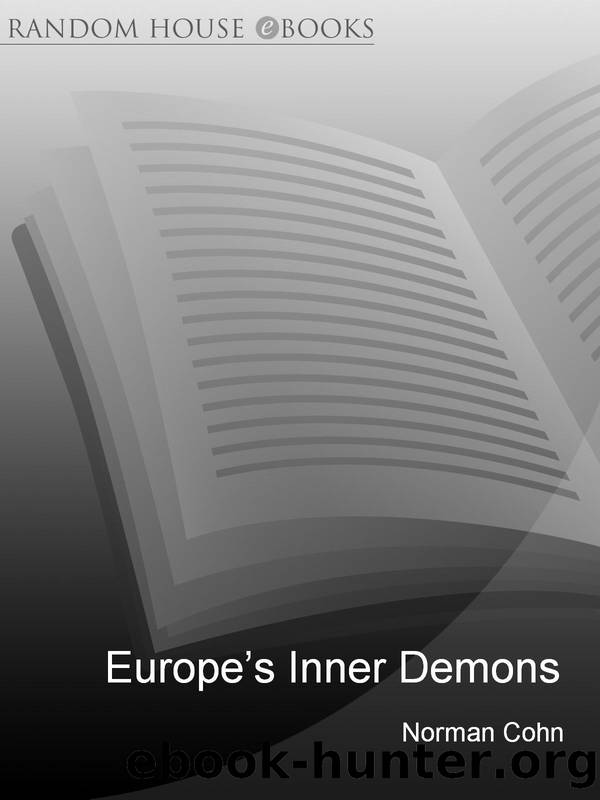Europe's Inner Demons by Norman Cohn

Author:Norman Cohn
Language: eng
Format: epub
ISBN: 9781448103935
Publisher: Random House
- 4 -
The trials we have just considered were all heresy trials, where the accused was charged, above all, with having personal dealings with a demon. In some of them maleficium also bulks large; and the combination of these two kinds of accusation, in the context of a trial conducted under the inquisitorial procedure, does mark a step in the direction of the great witch-hunt. Yet in itself it is only a small step. The accused in these trials were all charged as individual offenders, not as members of a sect. On the other hand, at the times and places where the witch-hunt reached its greatest intensity, witches certainly were thought of as constituting a sect â the most pernicious sect of all. The transition can be observed in two trials held in the fourteenth century. In both, the accusations are still formulated in terms of ritual magic, but the accused are thought of as an organized sect.
The earlier of the two trials was that of Lady Alice Kyteler and her associates; it was held at Kilkenny, in Ireland, in 1324â5.39 Lady Alice was a rich woman, descended from an Anglo-Norman family which had been settled in Kilkenny for some generations. Robert le Kyteler, of Kilkenny, was engaged in trade with Flanders towards the close of the thirteenth century; and Lady Alice added to the family wealth by marrying William Utlagh, or Outlaw, a rich banker and money-lender, also of Kilkenny. Later she married three more husbands. Adam le Blund, of Callan; Richard de Valle; and Sir John le Poer.40 She and her son by her first marriage, William Outlaw, attracted much hatred. Like his father, William Outlaw was a banker and money-lender and there are documents to show that many of the local nobles were heavily in debt to him. The reputation of mother and son is mirrored in a tale preserved in the Annals of Ireland. Lady Alice was believed to be in the habit of raking filth from the streets towards her sonâs door, muttering under her breath:
âUnto the house of William my sonne
Hie all the wealth of Kilkennie town.â41
But the fiercest hatred came from the sons and daughters whom Lady Aliceâs husbands had had by earlier marriages. These stepsons and stepdaughters of hers complained bitterly that, by her sorceries, she had killed some of their fathers and had so infatuated others that they had given all their wealth to her and her son William, to the perpetual impoverishment of the rightful heirs. They added that even her present husband was reduced to such a state by powders, pills and sorceries that he was wasting away, deprived of his nails, without hair on his body. Indeed it was said that Sir John le Poer, being warned by his wifeâs maid, forcibly opened her boxes and found there a sackful of horrible things, which he transmitted to the local bishop. They had not far to go, for Kilkenny was the episcopal city of the diocese of Ossory.
The bishop,
Download
This site does not store any files on its server. We only index and link to content provided by other sites. Please contact the content providers to delete copyright contents if any and email us, we'll remove relevant links or contents immediately.
Machine Learning at Scale with H2O by Gregory Keys | David Whiting(4183)
Never by Ken Follett(3794)
Fairy Tale by Stephen King(3220)
The Man Who Died Twice by Richard Osman(2997)
Reminders of Him: A Novel by Colleen Hoover(2952)
Will by Will Smith(2793)
Rationality by Steven Pinker(2291)
Can't Hurt Me: Master Your Mind and Defy the Odds - Clean Edition by David Goggins(2228)
It Starts With Us (It Ends with Us #2) by Colleen Hoover(2198)
Friends, Lovers, and the Big Terrible Thing by Matthew Perry(2119)
The Becoming by Nora Roberts(2088)
The Stranger in the Lifeboat by Mitch Albom(2050)
Love on the Brain by Ali Hazelwood(1965)
New Morning Mercies: A Daily Gospel Devotional by Paul David Tripp(1877)
HBR's 10 Must Reads 2022 by Harvard Business Review(1777)
The Strength In Our Scars by Bianca Sparacino(1776)
A Short History of War by Jeremy Black(1762)
Never Finished: Unshackle Your Mind and Win the War Within by David Goggins(1641)
515945210 by Unknown(1599)
